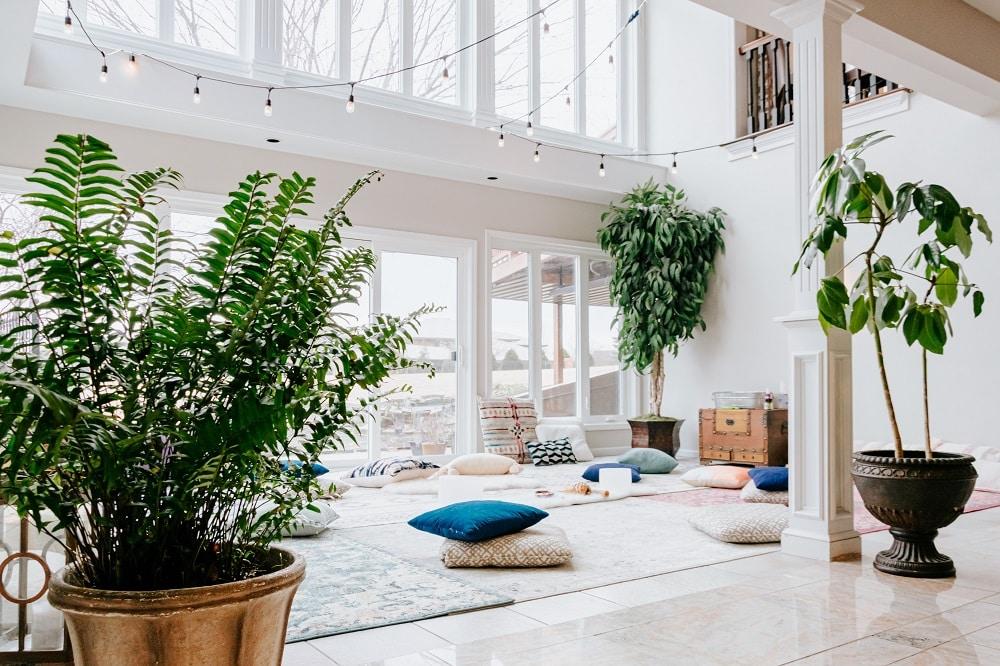Are you stuck in a rut and don’t know which flooring to install in your home?
When it comes to laying down the floor, people often tend to gravitate towards a select few types like wood, tiles, or concrete. These floors are excellent, no doubt, but are really mainstream and overused.
There are several types of flooring available on the market these days, and the options are limitless. No worries if you are clueless about this topic because we have prepared an extensive guide filled with innovative flooring ideas.
We’ll discuss several types of floors along with their different patterns and designs. By the end you’ll have a fair idea of the type of flooring you want around the home. Are you ready?
Let’s begin without further ado!
Types Of Flooring
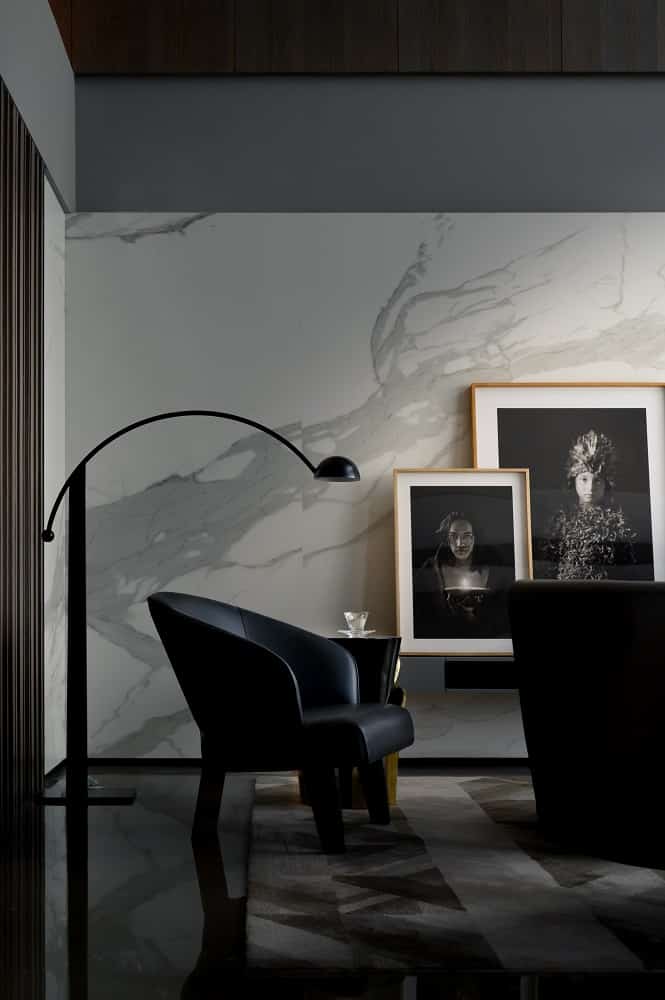
-
Hardwood Flooring
We’ll kickstart our list with the basic yet elegant flooring style that has been around for a long time – hardwood flooring. Along with being versatile and durable, hardwood floors are available in many different designs and patterns.
These floors are long-lasting since they are properly sanded down and finished during installation. We’d like to tell you that other wooden alternatives known as “engineered wood” are simply nailed-down or glued with the subfloor and are not as durable as authentic hardwood flooring.
So, let’s briefly look at the different patterns of hardwood floors:
-
Diagonal Pattern

The wooden planks are positioned at a certain angle from the walls and are aligned in one direction. Planks that run across the center of the room are the longest, whereas those in the corner are shorter.
Hence, diagonal patterns make the room appear bigger but require a lot of extra cutting and piecing than the mainstream straight design.
-
Herringbone Pattern

The herringbone design derives its name from its resemblance to the skeleton of a herring fish. This pattern consists of recurring wooden boards pieced together at right angles and each strip is rectangular and typically eighteen inches in length.
Also, the strips are arranged in a V shape, with the narrower end meeting the other strip perpendicularly.
-
Double Herringbone Pattern

As the name suggests, double herringbone is just an improvisation of the original herringbone pattern, with alternating Vs like that of a woven bamboo basket. We recommend using this design in smaller rooms since the double stack of the stripes creates an illusion of a large room.
-
Versailles Pattern

Now this one is an intricate pattern with traditional and vintage vibes. You’ll have to employ experienced professionals if you want to beautify your home with Versailles.
Adapted from the royal residence of Louis XIV, The Palace Of Versailles, the design consists of square patches. These patches have an outer border made of four wooden strips with a loose crisscross pattern in the middle, resembling a pie.
Naturally, it is one of the most beautiful and detailed designs available on the market.
-
Marble Flooring
Elegant, sleek, versatile, and durable are a few words that immediately pop up in mind when we start talking about a marble floor, don’t you agree? White marble is the most common type, but the options go beyond that with beige, black, green, pink, brown, red, blue, and gold.
Regardless of the color options, white is a favorite among people. However, you can beat the monotony by creating custom patterns on your floor using different shades. Additionally, marble is porous and can last for decades without breaking if maintained well.
That said, beware of the inferior quality stones on the market that claim to be original marble but become dull and yellowish over time. Real marble maintains its opulent shine for years without any degradation.
-
Diamond Motif
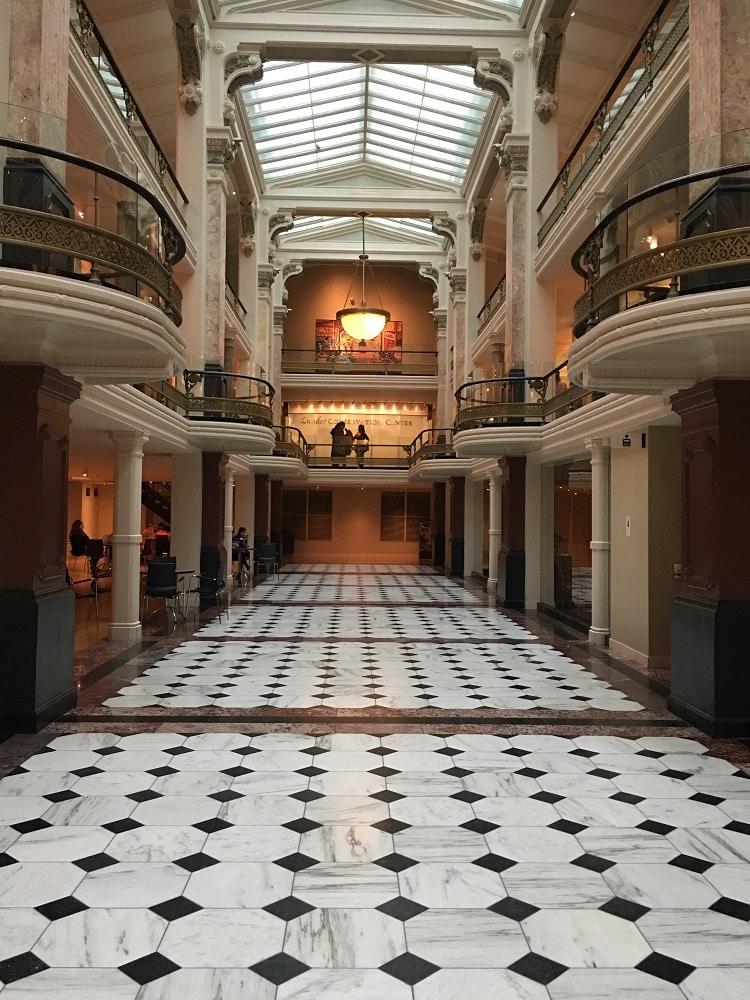
Whether you want a minimalist or a maximalist look, the diamond motif design can be used in both ways. A pristine plain white marble floor with scattered diamond motifs does not draw too much attention yet complements the overall luxurious feel, especially in living rooms or master bedrooms.
But if you want to go all-in with an eye-catching floor, we recommend opting for a large diamond pattern composed of four aggregate pieces. Either way, an elegant and luscious aura is guaranteed.
-
Straight Lay Marble
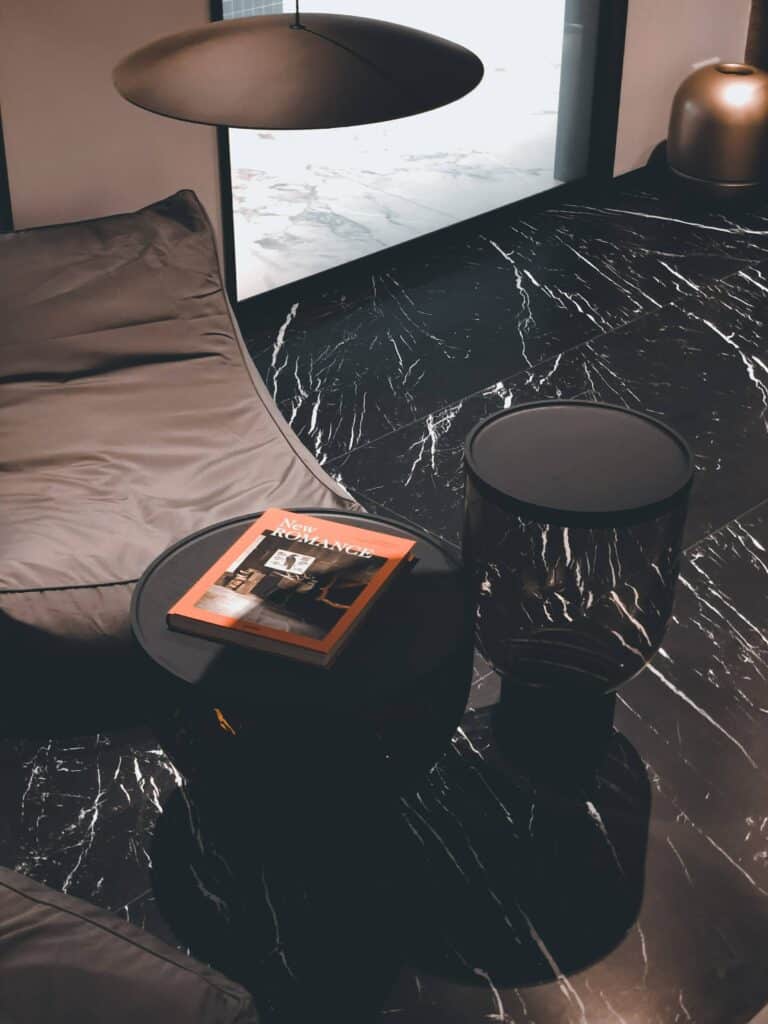
Straight-lay marble tiles are the simplest form of marble flooring, yet they manage to make a bold statement. The material is already cut into small tiles, which makes the installation process easier.
Marble tiles come in a lot of beautiful patterns, which you can directly lay down without using heavy machinery.
-
Bordered Marble Flooring
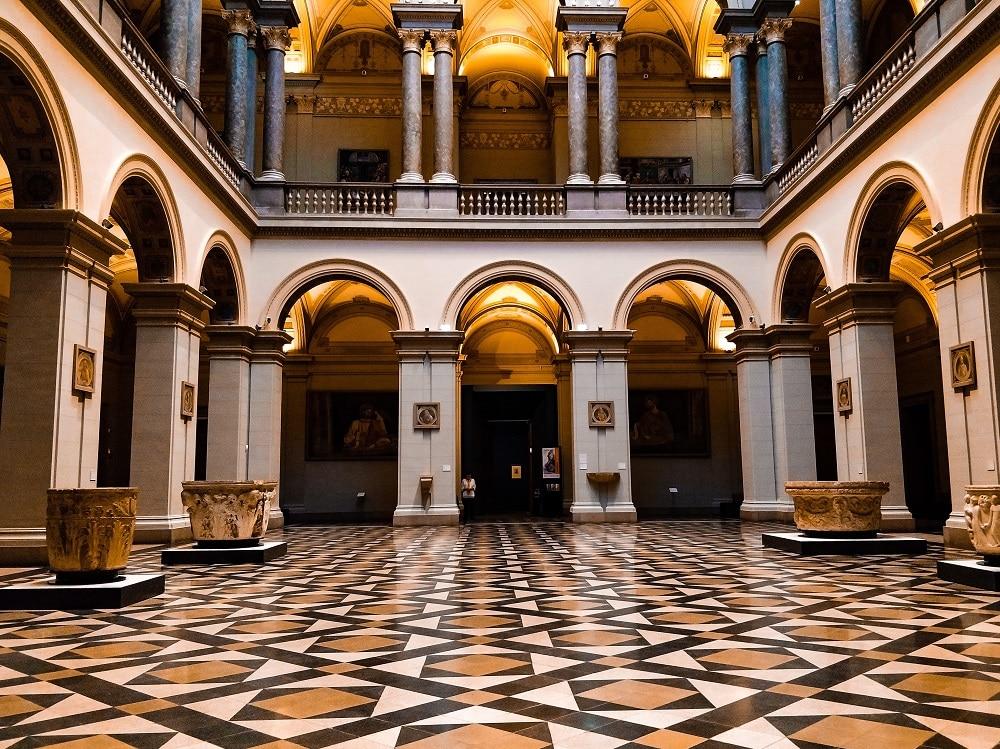
Are you a lover of antique furniture? If you want your décor to have vintage feels, then bordered marble is an easy and effective way to go about it.
Borders accentuate the floor and add a finishing touch to the space, especially in common areas like lobbies, dining rooms, and living rooms. You can keep the whole flooring neutral and complete it with a boundary in a darker shade.
For instance, black and emerald green marbles are immaculate and give a royal touch to the room.
-
Stripes And Geometric Marble Patterns

Marbles come in all sorts of patterns, and stripes are one of the more popular ones. They are simple and can perfectly balance the different elements of your indoor décor if used correctly. We’ll make that clear with a small example.
Supposing your walls are fairly plain and you want to keep the floor a little appealing but not too loud. Now that kind of balance is a little tricky to master, and that’s when striped marble comes into the picture. It’s neither too plain Jane nor too busily patterned, thereby subtly blending with solid painted walls.
Likewise, geometric patterns can be created on the floor using thin strips of colored marble (like those used for borders). Hence, it has a broad scope of experimentation, and you can decide whether you want the geometric design to be closely spaced or broadly scattered.
-
Vinyl Flooring
If you are looking for a versatile flooring option at a pocket-friendly price, then vinyl will most likely appeal to you. Why? Because vinyl is an all-rounder that can imitate any pattern you want at a much lower price than the original.
Though it won’t provide the sturdiness and authenticity of the original material like wood, marble, or granite, it is quite impressive when it comes to looks. Vinyl is, however, pretty durable because of its stain-proof and water-resistant formula but needs special care to prevent scratches.
Another unique factor is that you can enjoy the looks of a surface that tends to stay cold, like marble or stone, while enjoying the warmth of vinyl. This can throw people off guard because they expect a cold sensation assuming the floor to be stone when in reality it is vinyl.
Despite all the good qualities, one apparent downside is that this material discolors over time, especially if overexposed to rubber.
-
Luxury Vinyl Tiles

Also referred to as LVT, these vinyl tiles are carbon neutral with 40 percent recycled content. Super easy to cut, resize, and design, the tiles already come in manageable sizes for convenient transportation.
LVTs overcome the typical scratch-prone drawback in vinyl, as they come coated with a ceramic bead protective layer. Not only are they scuff-proof and scratch-resistant, but they also have a layer of fiberglass between the two core sheets, which makes them flexible and dimensionally stable.
-
Luxury Vinyl Planks

This flooring gives the elegant effect of a hardwood floor with the benefits and features of regular vinyl. An LVP floor is very strong and durable since it is composed of multiple resilient layers.
The bottom-most layer is known as the backer board and serves as an elastic and stable base built out of PVC. But it is the middle layer that provides strength to the flooring and is water-resistant since the vinyl layer is right above it. This determines the appearance of the floor, and it could be mimicking stone, marble, wood, etc.
Also, the top-most layer is the wear layer which serves as a scratch-resistant and protective surface. It is thin, and clear, and prevents staining.
You will see that the thickness of the clear layer varies according to the usage with 12 millimeters and higher used for commercial-grade applications. Anything below 20 millimeters is fit for light use and residential purposes.
-
Rigid Core Vinyl

Rigid core vinyl is basically an improvised version of the material which is engineered for additional stability. It is essentially like a solid plank because of which it is slightly less flexible than normal vinyl but makes up for that in terms of strength.
Just like LVP, the rigid core is also a composite vinyl and is constructed of four layers: a strong core layer, a water-resistant layer, one wear layer on the top, and a basal layer which may or may not be present.
The core layer is strong and is composed of either wood or a compound layer of plastic and stone. It may or may not have an underlying attachment for extra cushioning and noise absorption. This feature is good if you live in an apartment and don’t want to disturb the downstairs neighbors.
-
Vinyl Sheets

If you think of vinyl sheets and an old and retro look pops into your head, then we’ll have to break it to you. That is not the case anymore. The sheets have undergone major transformations over the last few years and are now available in better colors, textures, patterns, and finishes.
Vinyl sheets give the most realistic ceramic tile, hardwood, or stone at an affordable price. You should definitely look into them if you are looking for cost-effective flooring options.
-
Concrete Flooring
Concrete is known for its versatility because you can very easily mold it into various styles, patterns, and colors to complement your interior décor. The formula is a concoction of rocks, cement, and granite chips, along with some other adhesive materials, and is highly durable.
Apart from a little scratching and chipping, concrete is largely a damage-proof flooring option. But it does not react well to moisture and should not be used in rooms that stay humid, like kitchens and bathrooms.
The best part about concrete is that it offers a wide range of experimentation and customization. You can literally shape it however you want, mix it with whichever paint you prefer, and lay it down in a number of patterns.
-
Polished Concrete
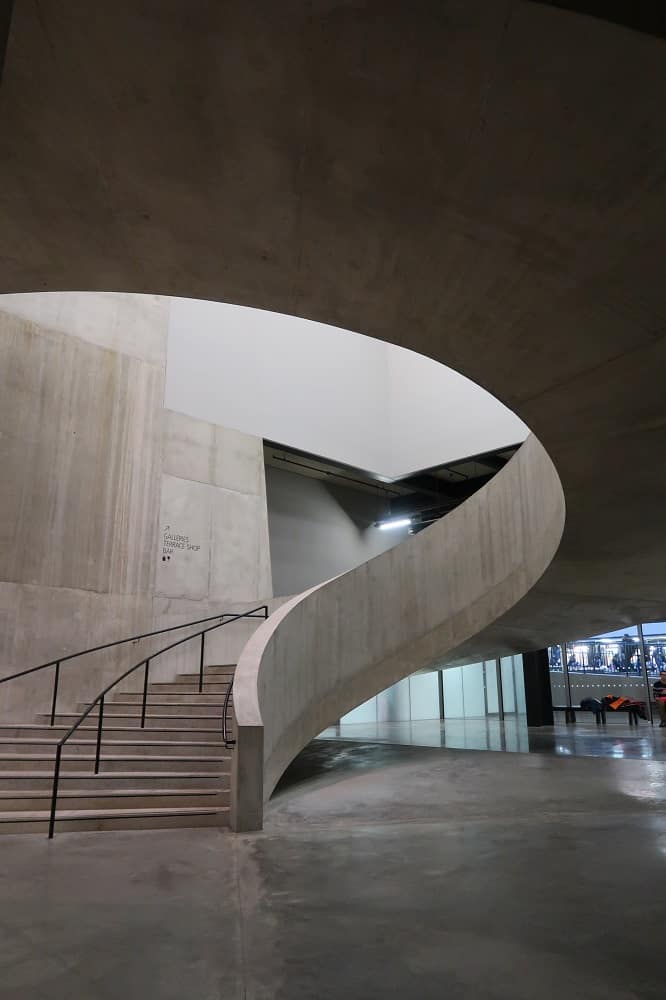
Starting with the most basic type, we have subtle yet classy polished concrete flooring. It is a competent option for use on ground floor levels because it reflects the light across the room very well.
In addition, polished concrete is very sleek and clean and makes the area appear large and spacey. If your home has a lot of natural light, then we recommend trying this pattern of flooring in your courtyard or lobbies. There’s a type of polished floor known as “mud flooring,” which gives an amazing vintage and rustic vibe if you are looking for something along those lines.
-
Acid-Stained Concrete

Breathe some life into your boring floor by adding a little acid staining, borders, custom designs, and emblems. Acid-stained concrete floors are vivacious to look at and uplift the whole mood of the room.
The procedure involves the use of metallic stalks and acid dyes that are acetone-based. Are you familiar with the “etching” of concrete? It is a method that opens up the pores of the concrete floor, making them more susceptible to metallic salts and stains.
The salts react with the calcium hydroxide present in the cement and change the color of concrete floors, giving it an artistic stain. If you want to incorporate emblems or custom-made designs into the flooring, then you’ll have to get them designed beforehand and get some professionals for the installation.
-
Diamond Pattern Concrete

Predominantly used in lobbies, entrance hallways, and waiting rooms, diamond pattern concrete floors require a fair amount of dedication for installation. It should be symmetrically stenciled with accuracy for the design to pop out.
Though patterned concrete is a little time-consuming, it is phenomenal to look at once finished. It works well in large areas like living rooms and areas that lead to the entrance of other rooms.
-
Wood-Stamped Concrete

Wood is the preferred material when it comes to building decks or patios, but one obvious setback is, wooden planks warp and deteriorate when overexposed to sun or adverse weather conditions.
You can go with a wood-stamped concrete floor to overcome this hurdle and still have the wooden feel on your patio. Concrete is much more weather-resistant and can deal with moisture better if polished and sealed well.
-
Epoxy Flooring
Epoxy floors are ultra-modern and the current hot pick when it comes to the latest flooring trends. They are made of a combination of resin polymers and chemical hardeners and form a strong bond with the base of the floor.
People often confuse epoxy flooring with epoxy coating, but we’ll clarify that the primary difference between the two is their thickness. Epoxy coating is just an additional coat applied on top of a floor, whereas epoxy flooring is quite thick (more than 2 millimeters) and forms the basic groundwork of the floor.
This flooring is laid on top of a concrete base and consists of several layers of the combination formula. The compound is thick and strong, extremely heat and water-resistant. It is bound to last for a long time with a negligible need for maintenance in your home.
-
Self-Leveling Epoxy Floors

Self-leveling epoxy floors are mainly used for renovation purposes and are fantastic for covering old chipped or damaged concrete flooring. They provide a seamless and shiny look and are available in a wide range of colors and textures.
The flooring is called “self-leveling” because you just need to pour the formula gently over the old concrete, and it adjusts itself on the cracks and depressions effortlessly. You don’t have to pay much attention to consistency and maintaining a uniform thickness while applying because of this amazing feature.
What’s more, the flooring is durable and attractive in looks. Epoxy floors generally cost more than other options on the market but compensate for it by sticking around for a long time and saving on maintenance costs.
-
Quartz-Filled Epoxy Floors
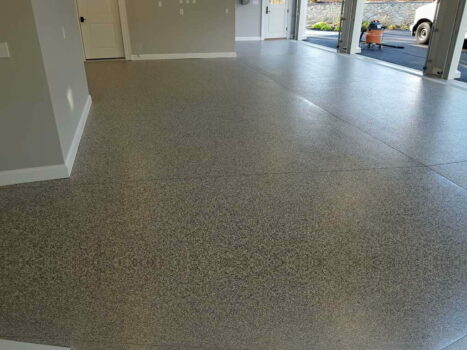
This one is the most aesthetically pleasing type of epoxy flooring with a formula that combines the toughness of epoxy polymer resin with the beauty of stained quartz granules. Finding a formula that is both strong and visually appealing is rare, and hence this flooring type is a hit among customers.
These floors are ideal for use in areas that need slip-resistant and sanitary properties and therefore are preferred for bathrooms, showers, and kitchens. And, the highlight is the quartz grains reflect light and appear to shine, making the flooring fit for decorative spaces.
-
Epoxy Flake Floors

If you want a vibrant multi-colored look, then epoxy flake might be the flooring that you’ve been looking for. Giving close competition to quartz epoxy in terms of looks, the formula contains tiny colored flakes inserted inside the epoxy.
The multi-colored flakes are not only pretty to look at but also form subtle ridges and grooves on the floor to increase the surface area and reduce the chances of slipping and falling. Additionally, the flooring is available in a variety of colors, styles, sizes, and textures and can be customized uniquely for different rooms.
-
Epoxy Mortar Floors

One of the most stringent flooring systems, epoxy mortar, is made of a hundred percent rock-solid epoxies and quartz or graded stand. This high-grade flooring is suitable for use in mechanical spaces like warehouses and garages, and therefore performs well in driveways and home garages.
This flooring is perfect for spaces that need extra strength and durability for dealing with heavy-duty equipment. Driveways have to sustain both vehicular traffic and foot traffic, and epoxy mortar provides the tensile strength to keep up with it.
-
Granite Flooring

Granite contains an array of small components like mica, feldspar, silica, and quartz and is loved by homeowners and connoisseurs worldwide. Exuding luxury and elegance, granite floors are sleek and create a plush look wherever installed.
However, you need to consider a few key factors for picking the right type of granite stone for your flooring. They come in different patterns like brushed granite, flamed granite, and polished granite. We recommend looking at all the options instead of sticking to the basic one.
Granite floors have a uniform and organic effect because they come in natural colors like deep green, brown, and black. They look elegant in living rooms and dining areas but should be avoided in bathrooms because of their slippery surface.
-
Laminate Flooring

Last but not least, we have economical, inexpensive, and functional laminate flooring. These floors are hybrid covers composed of a top-most wear layer, a middle image layer, and a particle board wooden base.
This type of flooring is well suited for most rooms of the house, including the dining area, living area, kitchen, bedroom, and hallway. The only thing is they swell up in moist conditions, and hence, should not be installed in bathrooms or toilets.
Acoustic Considerations in Flooring Choices
The acoustic properties of different flooring materials significantly influence sound transmission within a space. Hard materials such as hardwood and concrete often reflect sound, potentially causing echoes or amplifying noise within the room. Conversely, softer materials like carpet can absorb sound more effectively, reducing echoes and attenuating ambient noise.
The acoustic performance of various flooring types can be enhanced through several strategies. Among these is the use of underlays or soundproofing membranes that can absorb sound and mitigate its transmission through the floor. Additionally, furnishing strategies such as adding rugs or carpets on harder floor surfaces can contribute to improved sound absorption.
The selection of flooring materials should therefore take into account not only aesthetic and durability aspects but also their acoustic properties. This can support the creation of a comfortable acoustic environment, enhancing the functionality and livability of the space.
For further information on soundproofing strategies applicable to a range of flooring types, consider consulting the guide on tile floor soundproofing. Though the focus is on tile flooring, the guide includes principles and practices that can be generalized to different flooring materials.
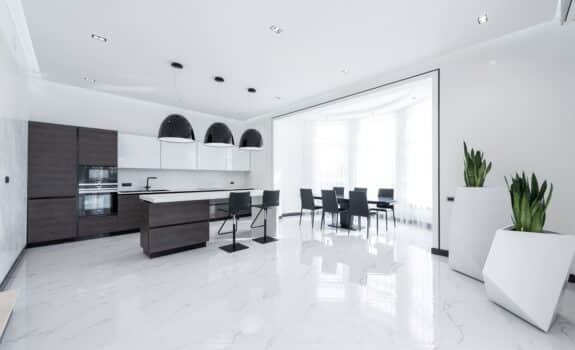
Conclusion
Deciding on a floor type is a hefty task since flooring plays a crucial role in the overall décor of the house.
With that being said, we hope that you have got a fair idea of all the latest trends after reading our detailed guide. Before signing off, we’ll let you in on our favorite picks.
Marble floorings are pristine and elegant, making them the best options for living rooms. On the other hand, granite has a natural look and fits well in kitchens and dining halls.
We’ll see you next time! Take care.
Related Articles
40 Types of Engineered Flooring | Pros, Cons, and Costs
Types Of Decking 101 | All You Need to Know
13 Types of Bamboo for Indoors, Decks, Gardens & Yards to Consider
14 Best Basement Flooring Options Right Now
10 Pros and Cons of Hardwood Flooring You Should Know
What Is Laminate Flooring And How To Use Them In Interior Design



